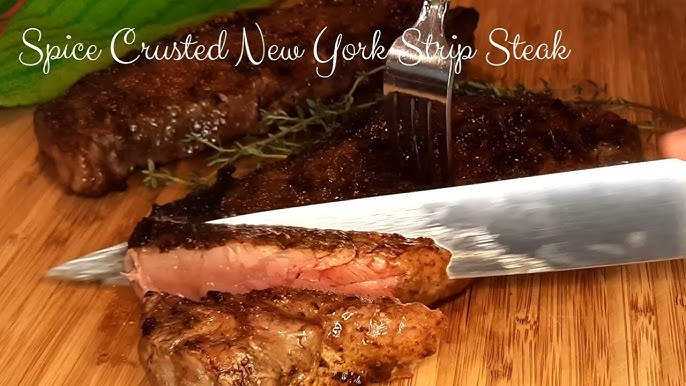New York Steak Recipe: Who doesn’t love a juicy, flavorful New York steak? Whether you’re prepping for a weekend dinner or impressing guests on a special night, the New York strip steak is your go-to hero in the kitchen. This cut is known for its robust beefy flavor, tenderness, and beautifully marbled texture that crisps up perfectly when seared. But the secret to a steakhouse-worthy New York strip at home isn’t just in the cut—it’s in how you cook it.
Before we dive into the recipe, let’s take a moment to understand why this cut stands out. The New York strip, often called the strip loin, comes from the short loin of the cow. This area gets little exercise, which means the meat is more tender compared to other cuts. It’s boneless, has a firm texture, and offers a satisfying chew. Think of it as the perfect balance between tenderness and flavor.
Ingredients and Tools You’ll Need
Before you touch the skillet or fire up the grill, gather everything you need. The key to stress-free cooking is preparation. Here’s what you’ll need for a classic, no-fail New York steak:
Essential Ingredients:
- 2 New York strip steaks (1.25 to 1.5 inches thick)
- Kosher salt
- Freshly ground black pepper
- Garlic cloves (optional)
- Fresh rosemary or thyme sprigs
- 2 tablespoons of olive oil or high-smoke-point oil
- 2 tablespoons of unsalted butter
Optional Add-ons:
- Crushed red pepper flakes for heat
- Steak seasoning blends (if you’re feeling adventurous)
Must-Have Tools and Equipment:
- Cast-iron skillet or grill pan
- Tongs
- Meat thermometer (a must for perfect doneness)
- Aluminum foil (for resting)
- Cutting board and sharp carving knife
Being well-equipped ensures precision and consistency. Whether you’re a beginner or a seasoned home cook, these tools are your best allies in mastering the art of the steak.
How to Make New York Steak – Step by Step Guide
Step 1: Choosing the Right Steak
You can’t make a stellar New York steak without starting with quality meat. When you’re at the butcher or grocery store, knowing what to look for can make or break your dish.
USDA Grades and What They Mean:
The USDA grades beef based on tenderness, juiciness, and flavor. Here’s a quick guide:
- Prime: Highest quality with abundant marbling. Best for grilling and pan-searing.
- Choice: Less marbling than prime but still excellent in taste and tenderness.
- Select: Leaner with minimal marbling. Affordable but less juicy.
If your budget allows, go for USDA Prime. It’s worth every penny in terms of flavor and juiciness.
Thickness and Marbling Considerations:
Aim for a steak that’s at least 1.25 inches thick. Thin steaks tend to dry out quickly, while thicker ones allow for a good sear without overcooking the interior.
Marbling—those white flecks of fat running through the meat—is gold. It melts during cooking, making the steak juicy and flavorful. Avoid cuts with thick exterior fat caps that won’t render down easily.
Step 2: Prepping the Steak
This step might seem simple, but it’s where a lot of people trip up. Prepping your steak correctly sets you up for success in the pan or on the grill.
Bringing the Steak to Room Temperature:
Always let your steak sit at room temperature for 30–45 minutes before cooking. Cold steak straight from the fridge cooks unevenly. Room temperature meat ensures a nice crust and even center.
Seasoning Techniques for Maximum Flavor:
Salt and pepper are more powerful than they look—especially kosher salt, which clings to the meat and brings out its natural flavors. Season liberally, at least 15 minutes before cooking. This gives the salt time to penetrate and tenderize the meat.
Want to elevate the flavor? Add a rub of crushed garlic, rosemary, and a drizzle of olive oil. Let it marinate briefly while the steak comes to temperature.
Step 3: Cooking the Steak
Now, the moment of truth. Whether you’re team pan-sear or team grill, what really matters is temperature control, timing, and that magical crust.
Pan-Searing vs. Grilling: What’s Better?
- Pan-Searing: Ideal for home cooks. A cast-iron skillet gives you a gorgeous crust and more control over the cooking process.
- Grilling: Great for that smoky, charred flavor. But managing heat zones is crucial.
Step-by-Step Cooking Instructions:
- Heat your pan or grill until it’s smoking hot. This ensures an immediate sear.
- Add oil, then place the steak in the pan away from you to avoid splatters.
- Sear without moving for 2-3 minutes. Flip and repeat.
- Add butter, garlic, and herbs to the pan. Baste the steak with the melted butter for enhanced flavor.
- Use a meat thermometer:
- Rare: 120°F
- Medium Rare: 130°F
- Medium: 140°F
- Medium Well: 150°F
- Well Done: 160°F+
Always cook slightly below your target temperature—the steak will rise a few degrees while resting.
Step 4: Resting the Steak
You’ve seared your steak to perfection, the kitchen smells amazing, and you’re ready to dive in—but wait! Resting your steak is not just a suggestion—it’s essential. Skipping this step is like taking a cake out of the oven and cutting it immediately; all the goodness runs out.
Why Resting Matters:
When a steak cooks, its juices are pushed toward the center. Cutting into it too soon causes all that flavorful juice to spill out onto your plate instead of staying in the meat. Resting allows the juices to redistribute, resulting in a moist, flavorful bite from edge to center.
How Long Should You Rest Your Steak?
As a general rule:
- Rest the steak for 5–10 minutes for cuts under 1.5 inches.
- Go up to 15 minutes for thicker cuts.
Rest the steak loosely under a piece of aluminum foil to keep it warm. Don’t wrap it too tightly—you don’t want it to steam and lose that beautiful crust.
While it rests, this is a good time to prep your sides or whip up a quick pan sauce using the drippings left in the skillet.
Step 5: Slicing and Serving
You’re almost there! But slicing the steak properly is just as important as everything that came before. One wrong slice and you could turn a tender steak into a chewy mess.
How to Slice Against the Grain:
The “grain” refers to the direction of the muscle fibers in the meat. Slicing against the grain (perpendicular to the fibers) shortens them, making each bite more tender.
Here’s how to do it:
- Place the steak on a clean cutting board.
- Identify the direction of the muscle fibers.
- Slice across the grain using a sharp carving knife at a slight angle for a steakhouse presentation.
Perfect Pairings: Sides and Sauces:
A great steak deserves great company. Here are some classic and creative sides to elevate your dish:
- Garlic mashed potatoes
- Creamed spinach
- Grilled asparagus
- Roasted Brussels sprouts
- Buttered corn on the cob
Want a sauce? Try these easy ones:
- Classic peppercorn sauce
- Garlic herb butter
- Red wine reduction
- Chimichurri
Serve your steak hot, with a light drizzle of resting juices over the top for that extra burst of flavor.
Tips for Perfecting Your New York Steak
Cooking the perfect steak isn’t rocket science, but a few insider tips can take your dish from good to unforgettable.
Common Mistakes to Avoid:
- Cooking cold steak: Always bring it to room temp before cooking.
- Skipping the thermometer: Don’t rely on the “press test” unless you’re a seasoned pro.
- Not resting the steak: We can’t stress this enough!
- Over-seasoning: Let the meat speak for itself—salt and pepper go a long way.
- Flipping too often: One flip is usually enough. Let the crust form undisturbed.
Pro Tips for Restaurant-Quality Results:
- Dry-brine your steak overnight: Season with salt and let it sit uncovered in the fridge for 12–24 hours. This enhances both texture and flavor.
- Use compound butter: Mix softened butter with herbs, garlic, or even blue cheese, and place a dollop on the steak just before serving.
- Reverse sear for thick cuts: Cook the steak slowly in the oven until nearly done, then sear it in a hot pan for a crust that’s out of this world.
- Use a cast-iron skillet: It holds and distributes heat better than any other pan.
Master these tips and you’ll never settle for mediocre steak again.
Nutrition Facts and Health Insights
A well-cooked New York steak isn’t just delicious—it can also be a great source of essential nutrients when eaten in moderation.
Calories, Protein, and Fat Breakdown (Per 6oz Cooked Steak):
- Calories: ~400–450 kcal
- Protein: ~40–45g
- Total Fat: ~25–30g
- Saturated Fat: ~10–12g
- Cholesterol: ~120mg
- Iron: 15% of Daily Value
- Vitamin B12: 100% of Daily Value
New York steak is a protein powerhouse. It fuels muscle growth and keeps you full longer. It’s also rich in vitamin B12, iron, zinc, and creatine—nutrients crucial for energy, brain health, and recovery.
Health Benefits of Lean Red Meat:
- Builds muscle and supports immune function.
- Improves oxygen transport in the blood.
- Aids in neurological health.
However, moderation is key. Pair your steak with fiber-rich vegetables and healthy fats for a balanced meal. Avoid overindulging, especially with heavy, fatty sauces or carb-heavy sides every time.
FAQs about New York Steak Recipe
What is a New York steak?
A New York steak, also known as a New York strip or striploin, is a tender cut of beef from the short loin of the cow. It’s known for its rich flavor, perfect marbling, and firm texture.
How should I cook a New York steak for the best flavor?
For the best flavor, sear the steak on high heat for 2-3 minutes per side in a hot skillet, then finish in the oven to your desired doneness. Always let it rest before slicing.
Should I marinate a New York steak?
Not necessarily. The New York strip is flavorful on its own, so a simple seasoning of salt, pepper, and garlic is enough. However, if you prefer, a light marinade can enhance its taste.
What’s the best doneness level for a New York strip steak?
Medium-rare is often considered ideal (130–135°F / 54–57°C). It brings out the juiciness and tenderness without overcooking the meat.
Can I grill a New York steak?
Absolutely! Grilling is one of the best methods. Preheat the grill, sear each side over high heat, then move to a cooler section to finish cooking to your preferred doneness.
What sides pair well with New York steak?
Classic sides include mashed potatoes, grilled asparagus, garlic butter mushrooms, roasted vegetables, and a fresh garden salad.
How long should I let the steak rest after cooking?
Let the steak rest for at least 5–10 minutes. This helps the juices redistribute, keeping the meat moist and flavorful.
Can I cook New York steak in an air fryer?
Yes! Season it well, cook at 400°F (200°C) for about 8–12 minutes, flipping halfway through. Always check internal temperature for desired doneness.
How do I store leftover New York steak?
Wrap it in foil or place in an airtight container and refrigerate for up to 3 days. Reheat gently to avoid drying it out.
Is New York steak the same as ribeye?
No. While both are premium cuts, ribeye has more fat and marbling, making it juicier, whereas New York strip is leaner but still tender and flavorful.
Conclusion
Cooking a perfect New York steak at home is all about technique, timing, and quality ingredients. From selecting the right cut to letting it rest and slicing it the right way, each step plays a role in creating that steakhouse-level experience. With a bit of practice and patience, you’ll master this dish and impress every guest who walks through your door.
So the next time you crave something hearty and satisfying, skip the restaurant bill and treat yourself to a home-cooked masterpiece.



